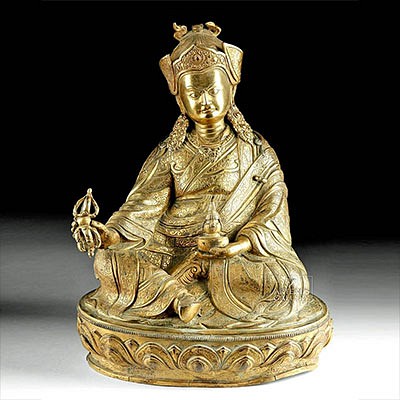Antique Indian Brass Ganesh Figure
Lot 88a
About Seller
Artemis Fine Arts
686 S Taylor Ave, Ste 106
Louisville, CO 80027
United States
Selling antiquities, ancient and ethnographic art online since 1993, Artemis Gallery specializes in Classical Antiquities (Egyptian, Greek, Roman, Near Eastern), Asian, Pre-Columbian, African / Tribal / Oceanographic art. Our extensive inventory includes pottery, stone, metal, wood, glass and textil...Read more
Categories
Estimate:
$2,000 - $3,000
Absentee vs Live bid
Two ways to bid:
- Leave a max absentee bid and the platform will bid on your behalf up to your maximum bid during the live auction.
- Bid live during the auction and your bids will be submitted real-time to the auctioneer.
Bid Increments
| Price | Bid Increment |
|---|---|
| $0 | $25 |
| $300 | $50 |
| $1,000 | $100 |
| $2,000 | $250 |
| $5,000 | $500 |
| $10,000 | $1,000 |
| $20,000 | $2,500 |
| $50,000 | $5,000 |
| $100,000 | $10,000 |
| $200,000 | $20,000 |
About Auction
By Artemis Fine Arts
Mar 11, 2021
Set Reminder
2021-03-11 12:00:00
2021-03-11 12:00:00
America/New_York
Bidsquare
Bidsquare : Art of Asia | Antiquity to Present
https://www.bidsquare.com/auctions/artemis-gallery/art-of-asia-antiquity-to-present-6497
Featuring antiquities, ancient and works of art ranging from the third millennium BCE to the present from China, Japan, South and Southeast Asia, and Korea. Including jades, bronzes, lacquer, textiles, paintings, prints, sculpture, ceramics, metalwork, and other art forms in other media. Artemis Fine Arts info@artemisfinearts.com
Featuring antiquities, ancient and works of art ranging from the third millennium BCE to the present from China, Japan, South and Southeast Asia, and Korea. Including jades, bronzes, lacquer, textiles, paintings, prints, sculpture, ceramics, metalwork, and other art forms in other media. Artemis Fine Arts info@artemisfinearts.com
- Lot Description
South Asia, India, ca. late 19th to early 20th century. A very large, finely cast brass statue of the elephant-headed deity Ganesha (also spelled Ganesh), the Lord of Good Fortune who provides riches, success, and general prosperity, standing upon a lotus pedestal with his right foot raised and bent at the knee, presenting with his endearing pot belly (a feature that is the result of his love for sweets and makes for an adorable silhouette), and holding his characteristic attributes in four upraised hands. Ganesh is adorned with an elaborate head ornament, a sunburst collar, epaulet like ornaments on his shoulders, a serpent slithering around his form, flowing leg coverings with a bejeweled belt, and bracelets. In addition, a rat/mouse (Ganesha's vahana) enjoying a little treat joins Ganesha on the lotus pedestal. Size: 11" L x 23.5" W x 35.5" H (27.9 cm x 59.7 cm x 90.2 cm)
Ganesha's four arms represent the four interior qualities of the body: mind (Manas), intellect (Buddhi), ego (Ahamkara), and conscience (Chitta). In the upper hands he holds an axe to fend against obstacles on the path to truth and righteousness and a pasha (noose). He also holds a pile of sweets in his lower left hand and a broken tusk in his lower right hand.
Esteemed as one of the principle deities of the Hindu pantheon, the first son of Shiva and Parvati, Ganesha is known as the Lord of Plenty or the god of auspiciousness, highly revered as the regulator of all obstacles with the power to create and remove them. Followers traditionally ask for his blessings at the beginning of any new paths or serious endeavors. The origin of his unusual physiognomy, particularly how he came to possess such an unusual head is the source of many legends, the most popular is that one day when Shiva was away from home, Parvati created a human son from her own body. She asked her son to guard the door while she was bathing. Quite unexpectedly, Shiva returned home, and the boy would not allow Shiva to enter his own household. Enraged by this, Shiva cut off the boy's head. Parvati grew quite angry and ordered Shiva to replace his head. Shiva did so with the head of the first living being he encountered, an elephant.
Provenance: private collection, Beaverton, Oregon, USA
All items legal to buy/sell under U.S. Statute covering cultural patrimony Code 2600, CHAPTER 14, and are guaranteed to be as described or your money back.
A Certificate of Authenticity will accompany all winning bids.
We ship worldwide and handle all shipping in-house for your convenience.
#162958A few minor casting flaws and slight softening to high pointed areas, but otherwise intact and very nice. Brass has developed a rich patina over time.Condition
- Shipping Info
-
All shipping is handled in-house for your convenience. Your invoice from Artemis Gallery will include shipping calculation instructions. If in doubt, please inquire BEFORE bidding for estimated shipping costs for individual items.
-
- Buyer's Premium



 EUR
EUR CAD
CAD AUD
AUD GBP
GBP MXN
MXN HKD
HKD CNY
CNY MYR
MYR SEK
SEK SGD
SGD CHF
CHF THB
THB
















